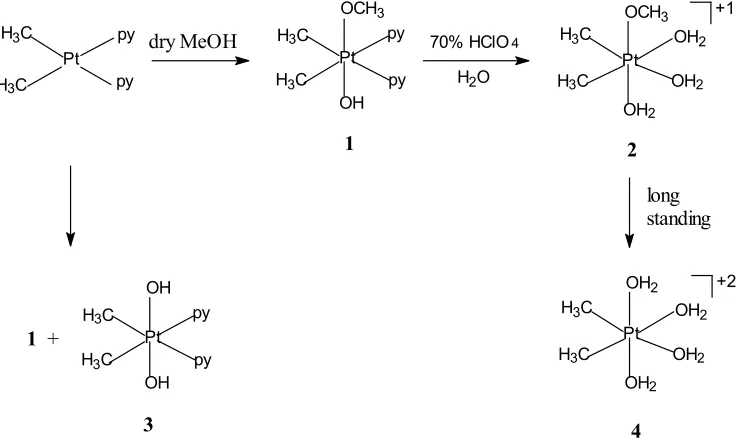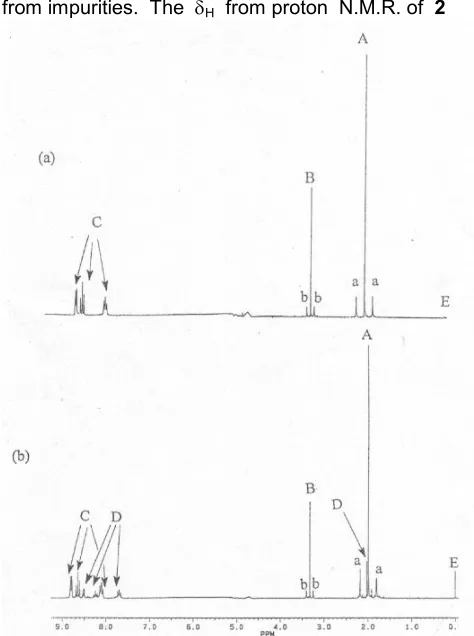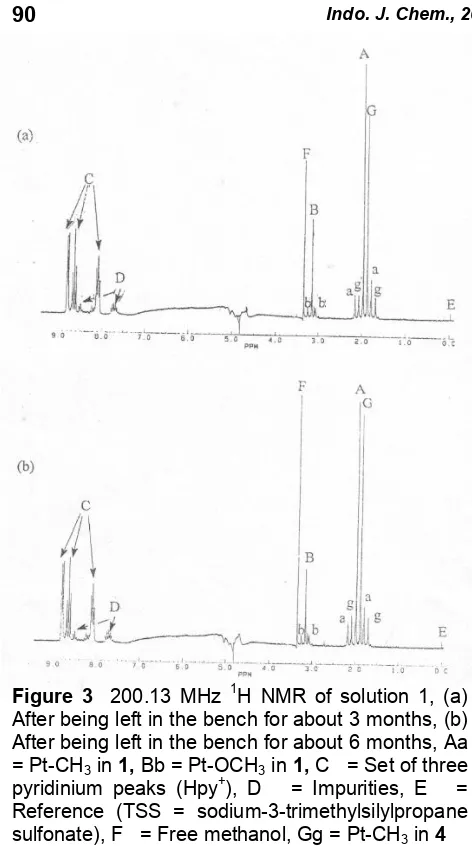THE SYNTHESIS AND NMR STUDY ON THE STABILITY
OF DIMETHYLMETHOXOPLATINUM(IV) COMPLEXES
Sutopo Hadi
*Chemistry Department, Faculty of Mathematics and Natural Sciences
University of Lampung, Jl. S. Brojonegoro No 1, Gedong Meneng, Bandarlampung 35145 Indonesia Received 16 April 2005; Accepted 28 April 2005
ABSTRACT
The synthesis of two stable platinum(IV) complexes containing methoxo ligand, [Pt(CH3)2(OCH3)(OH)py2] (1) and fac-[Pt(CH3)2(OCH3)(H2O)3] (2), has been successfully performed. Complex 1 was prepared by oxidative addition reaction of cis-[Pt(CH3)2py2] with dry methanol, and a subsequent reaction of 1 with 70 % HClO4 in water produced the platinum complex 2. The stability of complex2in acidic aqueous solution was investigated and monitored with1H and195Pt NMR. The platinum complex2was found to be quite stable toward hydrolysis and no-hydride elimination was observed.
Keywords:Methoxoplatinum(IV), NMR, complex stability, hydrolysis
INTRODUCTION
The preparation of new organoplatinum(II) and (IV) complexes is still challenging work which is currently still attracting much attention for platinum chemist. This is not merely due to their uses as anti-tumour agent such as in cisplatin complex,
cis-[Pt(NH3)2Cl2] and its derivatives and some new
class of platinum drugs [1] but they also look closely at the interesting features of some new class of the platinum complexes.
The NMR study for two methoxoplatinum(IV), [Pt(CH3)2(OCH3)(OH)(py)2] (1) and [Pt(CH3)2(OCH3)
(H2O)3]+(2) has been undertaken to find out and
understand the behaviour of these complexes and to monitor their stability in acidic solution. This was performed as it is believed that these methoxoplatinum(IV) complexes have interesting and different characteristics to those of platinum(II) alkoxide in particular or metal alkoxide complexes in general [2].
Most transition metal methoxo complexes, as generally known, are susceptible to hydrolysis of the M-OMe bond to give methanol and/or-hydride elimination to produce a metal hydride plus formaldehyde [3]. Complex 2, however, was prepared in boiling aqueous perchloric acid solution, and it was stable under the condition used.
Some other platinum(IV) complexes containing methoxo ligand, such as [Pt(CH3)2(OCH3)(OH)(bpy)].H2O [4] and
[Pt(CH3)2(OCH3)(OH)(ox)2]
2-[5] (bpy = 2,2'-bypyridil, ox2- = oxalate), have also been reported as relatively resistant to the decomposition reaction
that normally occurred in metal alkoxide complexes. So it would be interesting to have a new class of metal alkoxide complex which shows different characteristics to those metal alkoxides in general.
EXPERIMENTAL SECTION
General
The 1H NMR spectra were recorded on a Bruker AC 200 F spectrometer operating at 200 MHz fitted with a 5 mm 1H, 13C, 15N, 19F Quad Probe. A spectral width of 2,000 Hz - 2,500 Hz was employed together with 16 - 96 scans to obtain the desired F.I.D. A recycle time of 4 s was used with a pulse width of 3.6s (thus a tilt angle of 45 degrees was used). The number of data points obtained was 16K. All shifts are positive to higher frequency. 1H shifts are relative to the methyl signal of sodium 3-trimethylsilylpropane-1-sulfonate (TSS) for aqueous solvent and to internal tetramethylsilane (TMS) for non-aqueous solvents.
The195Pt spectra were recorded at 86.07 MHz on a Bruker AMX 400 spectro-meter fitted with a 5 mm broadband probe. The magnetisation tilt angle was 90°. A recycle time of 0.066 s was used with a pulse width of 23 s. The spectra obtained were both proton coupled and proton decoupled. A Spectral width used was 125,000 Hz. The number of scans used to obtain spectra varied from 1000 to 20,000. The number of data points obtained was 16K. 195Pt shifts relative to a separate sample containing an aqueous solution of Na2[PtCl6] (0.5 g
Materials
All solvents used were AR Grade. For some solvents (diethyl ether and methanol) were required further purification by standard method, for example, the following procedure has been used to purify diethyl ether: To 1 L of diethyl ether was added 200 g of CaCl2 anhydrous, it was kept in the
dark bottle for overnight, mixed with CaH2, and
finally distilled under either high purity grade Argon or Nitrogen.
Published methods were used to prepare PtCl2(NBD) (NBD = Norbornadiene or
bicyclo[2,2,1]hepta-1,3-diene) [6], Pt(CH3)2(NBD)
[7], andcis-Pt(CH3)2py2(py = pyridine) [8, 9].
Preparation of [Pt(CH3)2(OCH3)(OH)(py)2]
Cis-[Pt(CH3)2(py)2] (1 g, 2.611 mmol) was
dissolved in 40 mL of dry methanol. The solution was protected from moisture with a drying tube, but not from air, as it has been shown [10] that the analogous reaction of [Pt(CH3)2(bpy)] (bpy =
2,2'-bypyridil) with methanol proceeds only when dioxygen is present. The solution was allowed to stand for 6 hours or more. The solvent was then removed under high vacuum (reduced pressure) for 3- 4 hours. Further exposure of the sample to high vacuum produced a material whose 1H NMR spectrum showed no methoxide peak. The oily residue was washed successively with small volume of water, then with acetone, and dried in a vacuum desiccator over calcium chloride for several days. The resultant white solid was dissolved in the minimum volume of dichloromethane and reprecipitated by addition of n-hexane, filtered off,
washed with n-hexane and dried in a vacuum desiccator. Yield of analytically pure Pt(CH3)2(OCH3)(OH)(py)2] (1) was 80 %. (Elemental
of 70 % HClO4was added. The solid dissolved and
the solution was heated at 80 C for 15 minutes, and then filtered. The solution contained [Pt(CH3)2
(OCH3)(H2O)3] +
as well as pyridinium salt, Hpy+.
RESULTS AND DISCUSSION
The methoxoplatinum(IV) complex, [Pt(CH3)2(OCH3)(OH)(py)2] (1) was prepared by
oxidative addition of dry methanol to cis -[Pt(CH3)2(py)2] as shown in Fig 1. Rostovtsev et al.
[10] have shown that the reaction of [Pt(CH3)2(N-N)]
(N-N = bpy, phen and tmeda) with methanol always involves dioxygen. The mechanism of this reaction is not clear, but they suggested that radical intermediates are involved. It is likely that the reaction of cis-[Pt(CH3)2(py)2] with methanol in this
work also involves dioxygen
When the methanol used in this preparation reaction contains water molecules, without any further purification, there would be a competition between small portion water present in methanol and methanol itself withcis-[Pt(CH3)2(py)2] and this
will lead to a mixture of the product complex1 and the possible product [Pt(CH3)2(OH)2(py)2] (3).
The proton decoupled 195Pt NMR of 1 shows a singlet peak at –806 p.p.m. relative to Na2[PtCl6] as external standard. This peak is
similar to that of the product of reaction between [Pt(CH3)2(bpy)] and dry methanol,
[Pt(CH3)2(OCH3)(OH)(bpy)], -803 p.p.m.
Preparation of this compound was previous reported [4]. The complex 2 was obtained by a subsequent reaction of 1 with water and 70% perchloric acid and heating at 80C for 15 minutes. The amount of perchloric acid used and temperature control are very important, as they will affect the platinum product obtained.
In the 1H N.M.R. spectrum of 2 in D2O
solvent, the methyl groups give a singlet with satellites (A, a) at 2.04 p.p.m. and 2J (Pt – CH3)
75.6 Hz and another singlet with satellites peaks (B, b) from methoxide at 3.2 p.p.m. and 2J (Pt – CH3) 30.1 Hz as well as a set of three pyridinium
ion peaks, Hpy+present in the solution mixture. Figure 2 (a)) shows the spectrum when the product 2 was obtained in solution are clearly free from impurities. The H from proton N.M.R. of 2
Figure 1 200.13 MHz 1H NMR of (a) Freshly and cleanly prepared of solution 1 (b) Solution containing 1 with some impurities; Aa = Pt-CH3 in
1, Bb = Pt-OCH3in1, C = Set of three pyridinium
peaks (Hpy+), D = Impurities, E = Reference (TSS = sodium-3-trimethylsilylpropane sulfonate)
solution depends on the acidity of the solution used and the variation value range is about 0.1 - 0.2 p.p.m.
However, in the preparation of 2, there are often some impurities present as shown in the proton N.M.R. spectra (an example is in Figure 2 (b)). In Figure 2 (b), the impurity peaks labeled D correspond to three sets of pyridine peaks and a singlet with satellites from Pt – CH3.
The proton decoupled195Pt N.M.R. spectrum of a solution containing2 gives a sharp singlet peak at –556 p.p.m. relative to Na2PtCl6 as an external
standard . The proton coupled spectrum is a simple septet from Pt – CH3 coupling confirming that the
compound contained two Pt – CH3 groups, the
coupling with the methoxide proton was not resolved. ThePtis also dependent on the acidity of solution used in the measu-rement and the approximate range of this Ptis from -530 to -556 p.p.m. The more acidic the solution used, the more negative the value (the lower the frequency).
Part of the interest in complex 2 is its high stability toward both hydrolysis and -hydride elimination in this acidic aqueous solution. It is, however, not completely inert towards these reactions.
Slow hydrolysis occurs when the solution of 2 is left outside on the bench for long periods (2 months or more), but with exposure to normal laboratories light, no example of -hydride elimination was observed during the study of this complex.
The slow hydrolysis of 2 has been monitored mainly with 1H N.M.R (Figures 2 (a) and (b)) and
195
Pt N.M.R (Figure 3). From the 1H N.M.R. spectrum, after about three months, another singlet with satellite in methyl region was observed (G, g label) i.e. at 1.98 p.p.m. and 2J (Pt – CH3) 75.8 Hz
and this similar to what has been reported by Agnew
et al.9 (reported value: H2.04 p.p.m and 2J (Pt – CH3) 75.8 Hz), and this was accompanied by the
appearance of a singlet peak at 3.33 p.p.m which was assigned free methanol (F). The intensity of these additional peaks are continued to increase with time as the solution was left on the bench for about six months. This free methanol is derived from the methoxide bound to platinum, which was displaced by water as in Fig 1.
In195Pt N.M.R spectra (Figure 4), an additional peak appears at lower frequency, withPtvalue of – 587 p.p.m. (Figure 4 (b)). With time, the intensity of this additional peak increased and the intensity of the peaks form the parent compound decreased. These spectra strengthen the assignment of the new complex was as [Pt(CH3)2(H2O)4]+(4) (Ptreported by
Figure 3 200.13 MHz 1H NMR of solution 1, (a) After being left in the bench for about 3 months, (b) After being left in the bench for about 6 months, Aa = Pt-CH3in1,Bb = Pt-OCH3in1,C = Set of three
pyridinium peaks (Hpy+), D = Impurities, E = Reference (TSS = sodium-3-trimethylsilylpropane sulfonate), F = Free methanol, Gg = Pt-CH3in4
Figure 4 86.017 MHz 195Pt NMR of solution 2 (a) A freshly prepared; (b) After being left in the bench for 3 months (c) After being left in the bench for 6 months
Table 1NMR data of the platinum(IV) complexes
Complex Solvent Pt
p.p.m.
H(Me) p.p.m.
2
JPt-CH3
(Hz)
Other parameters (Hz)
[Pt(CH3)2(OCH3)(OH)(py)2]
(1)
CDCl3 -806 1.30 73.2 OCH3:H3.10 (42.4)
[Pt(CH3)2(OCH3)(H2O)3] +
(2) D2O -550 2.02 75.6 OCH3:H3.20 (30.2)
[Pt(CH3)2(OH)2(py)2] (3) CDCl3 a 1.85 71.0
-[Pt(CH3)2(H2O)4] 2+
(4) D2O -587 1.98 75.8
-a Not measured
The NMR data for all complexes observed presented in this work are tabulated in Table 1.
CONCLUSION
It has been shown that while the Pt – OC3
bond in [Pt(CH3)2(OCH3)(H2O)3] +
(2) is very robust, hydrolysis does occur over a long period in aqueous perchloric acid. The reactions of 2 with halide ions to see the stability Pt – OC3 bond has
been reported previously [12].
ACKNOWLEDGEMENT
REFFERENCES
1. Farrel, N.P., 1989,Transition Metal Complexes as Drugs and Chemotherapeutic Agents,
Kluwer Academic Publihser, Drodrecht, 60 2. Bradley, D.C., Mehrotra R.C., and Gaur, D.P.
1978, Metal Alkoxides.Academic Press, London, 1
3. Bryndza, H.E. and Tam, W., 1988, Chem. Rev., 88, 1163
4. Monaghan, P.K. and Puddephatt, R.J., 1984,
Organometallics, 3, 444
5. Dunham, S.O., Larsen, R.D. and Abbot, E.H., 1993,Inorg. Chem., 32, 2049
6. Drew, D. and Doyle, J.R., 1972,Inorg. Synth., 13, 48
7. Clark, H.C. and Manzer, L.E., 1973, J. Organomet. Chem., 59, 411
8. Hadi, S., Appleton, T.G. and Ayoko, G.A., 1998, Proceeding of 1st Brisbane Inorganic Chemistry Symposium, 13
9. Hadi, S. 2003. Prosiding Seminar Hasil-hasil Penelitian dan PPM DIES Natalis ke 38 Universitas Lampung, Bandar Lampung, 59 10. Rostovsev, V.V., Labinger, J.A., Bercaw, J.E.,
Lasseter, T.L., and Goldberg, K.I., 1998,
Organometallics, 17, 4530
11. Agnew, N.H., Appleton, T.G. and Hall, J.R., 1982,Aust. J. Chem., 35, 881
12. Hadi, S., Appleton, T.G. and Ayoko, G.A., 2003,


